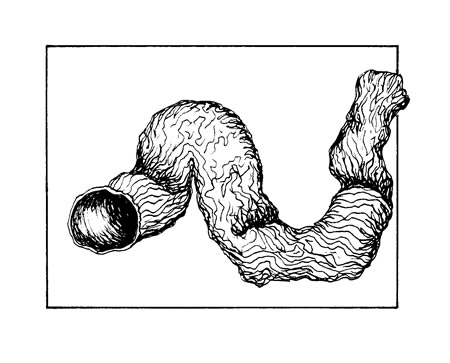Snails Find Home in a Tube

Deposited by the tides, a common find along Laguna’s eight-mile shore are broken off pieces of light colored irregularly curled, coiled and twisted tubes. Looking like homes for worms, the shells are actually a vermetid gastropod, a type of marine worm-snail called the scaly tube snail (Thylacodes squamigerus formerly Serpulorbis squamigerus). Living as solitary individuals or in colonies of several hundred that can reach several feet across, it is the only snail that cements itself to rocks or other solid surfaces such as kelp holdfasts where they remain permanently.
As the tube snail grows, it uncoils its calcareous shell to form irregularly shaped scaly tubes with ridges that travel lengthwise up to six inches in length and are ½ inch in diameter. Rough on the outside and smooth on the inside, the tubes are white or pale in color lightly stained in places with shades of pink, orange and yellow. The actual animal living inside the shell is dark colored and has the general anatomy of an uncoiled snail. Although it lacks an operculum (trap door) to seal the shell, it does have a circular foot which acts as a seal that is dark colored encircled first by a white ring, then an orange ring.

The scaly tube snail has a range from Monterey, Calif., to Baja California and is found in protected areas of the mid-intertidal to subtidal zone up to 65 feet deep. They are immobile creatures, and are filter feeders, dependent on water currents for food delivery. When covered with water, a fan of mucus is extended as far as six inches from the tube trapping plankton, detritus and other small organic organisms suspended in the water. Once the fan is retracted into the shell, the food is ingested. Its main predators are crabs and giant sea stars.
Sequential hermaphrodites, tube snails are born male but later turn female. Males release packets of sperm which are gathered into the females’ tube and held until used to fertilize eggs. These are brooded inside the mothers’ tube until they hatch and emerge as fully formed tiny young snails. After a very short time, the juveniles attach themselves to a hard surface and start growing into new clusters. Opportunities for shell observation are numerous along the eight miles of Laguna coast. When enjoying the natural resources, please enjoy gently and safely. All of Laguna Beach is a marine protected area, thus there is absolutely no collecting of shells including these intriguing calcareous tubes.
Local residents Mia Davidson and artist Jan Sattler are year round ocean swimmers who believe a better educated public will contribute to preservation of the marine habitat and its organisms.




